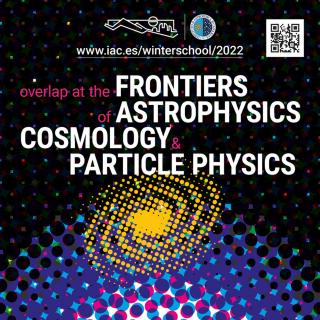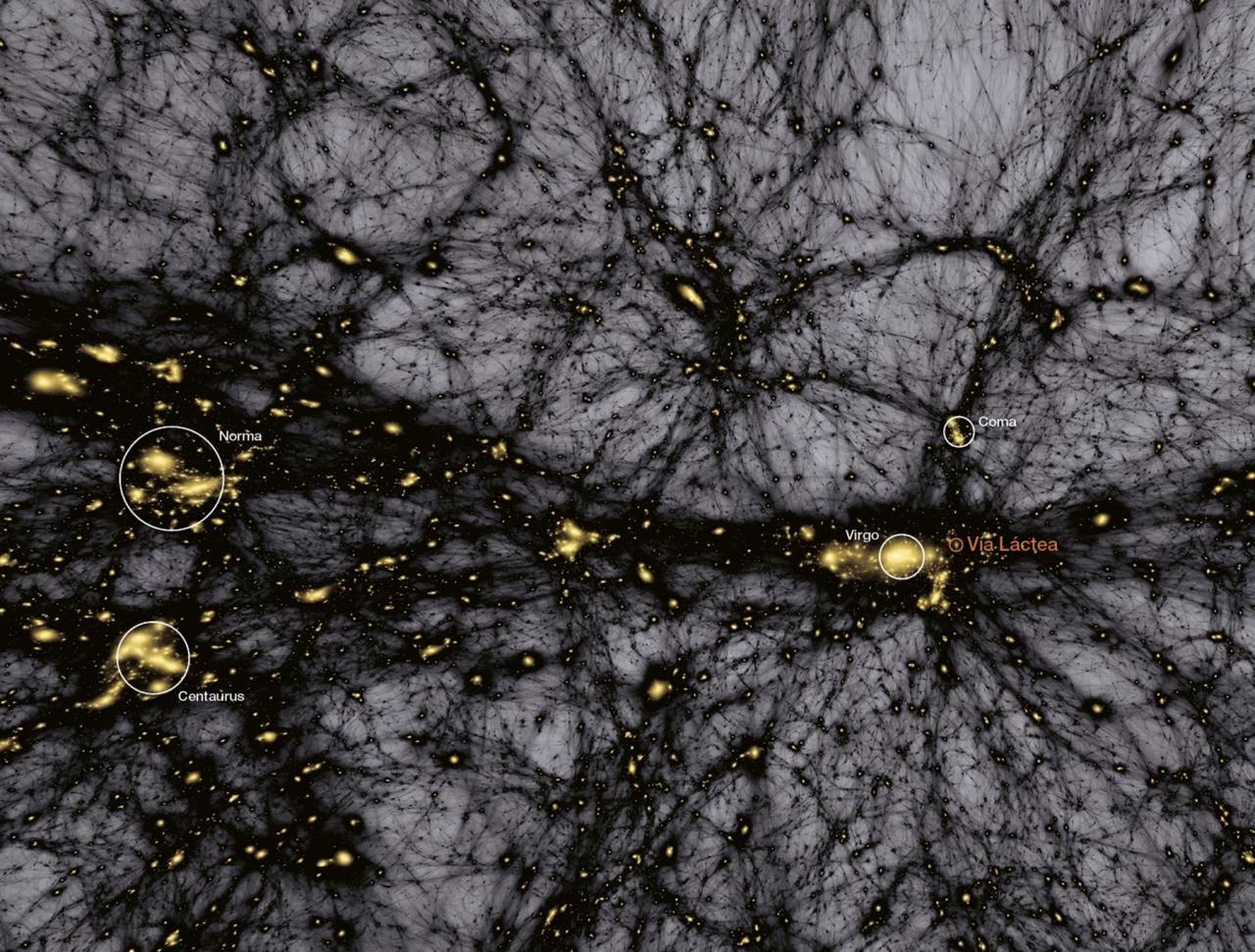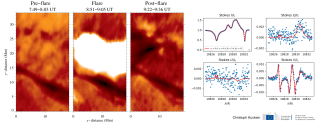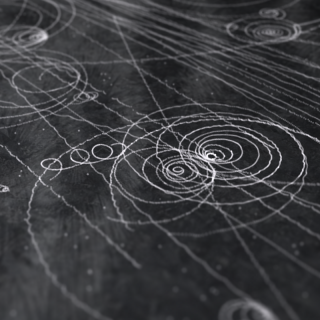Grants related:
General
The Cosmic Microwave Background (CMB) contains the statistical information about the early seeds of the structure formation in our Universe. Its natural counterpart in the local universe is the distribution of galaxies that arises as a result of gravitational growth of those primordial and small density fluctuations. The characterization of the distribution of inhomogeneities at large-scale in the local Universe provides a powerful tool, complementary to the CMB, to determine the origin and the energy content of the Universe, the expansion rate of the Universe during the cosmic history, and the detailed process of formation of the large-scale structures (LSS). The study of the LSS in the coming years will attempt to address the following open questions in cosmology:
What is the dark matter, and which is its detailed contribution to the energy content of the Universe?
What is the dark energy, and how it affects the dynamics of the Universe?
What is the connection between large scale structure and galaxy formation?
Do fundamental constants vary along the history of the Universe?
Is there evidence for primordial non-Gaussianities giving information on the details of the inflationary expansion epoch of the Universe?
In order to contribute to the possible answer to those questions, in this project we will use several large scale structure probes:
The distribution and large-scale clustering of the galaxies, and its evolution with time. The matter power spectrum (P(k)) and the two-point correlation function (ξ(r)) contain certain geometric features associated to some characteristic length-scales in the Universe, as the horizon at matter-radiation equality, or the acoustic horizon at last scattering. In particular, the latter determines the Baryon Acoustic Oscillation (BAO) scale.
The higher order statistics: the three-point statistics characterizes the deviation from Gaussinity and therefore the structure formation through gravitational instability, the galaxy bias, and the primordial non-Gaussianities.
The distribution of the cosmic voids in the Universe. Both the statistics of big voids, as well as the characterization of the void expansion, provides a complementary tool to determine the matter density and the equation of state of the dark energy. Cosmic voids contain information of the higher order statistics of galaxies and can be used to further constrain the BAO scale.
The cosmic web can be used to characterize the formation of structures and relate the large scale structure with galaxy formation processes.
The distribution and abundance of galaxy clusters, as well as the evolution with time. Among other parameters, the cluster mass function depends both on the matter density as well as in the amplitude of the power spectrum. The time evolution of the mass function n(M,z) is also govern by the growth of structures in the Universe, thus being also sensitive to the equation of state of the dark energy.
Members
Results
- eBOSS: cosmological analysis from the quasar sample. Marcos Pellejero Ibañez and F. S. Kitaura participated in the construction of the likelihood and the cosmological parameter estimation (including as coauthors Kitaura & Pellejero Ibañez: 2018MNRAS.473.4773A).
- EUCLID: comparison project of mock galaxy catalogue generating codes showing the accuracy and speed of the PATCHY code (including as coauthors Balaguera-Antolínez, Kitaura & Pellejero Ibañez:https://arxiv.org/abs/1806.09497, https://arxiv.org/abs/1806.09477, https://arxiv.org/abs/1806.09499)
- Development of an accurate Bias mapping method for large scale structure analysis (Balaguera-Antolínez, Kitaura, Pellejero Ibañez et al 2018:https://arxiv.org/abs/1806.05870)
- Presentation of the UNITSIM project to provide simulations for the theoretical model comparison for DESI and EUCLID (including as coauthors Kitaura & Pellejero Ibañez:http://www.unitsims.org/ https://arxiv.org/abs/1811.02111)
- Presentation of BARCODE (Bos, Kitaura & Weygaert 2018: https://arxiv.org/abs/1810.05189, http://adsabs.harvard.edu/abs/2018ascl.soft10002B)
Scientific activity
Related publications
-
PRISM (Polarized Radiation Imaging and Spectroscopy Mission): an extended white paper
PRISM (Polarized Radiation Imaging and Spectroscopy Mission) was proposed to ESA in May 2013 as a large-class mission for investigating within the framework of the ESA Cosmic Vision program a set of important scientific questions that require high resolution, high sensitivity, full-sky observations of the sky emission at wavelengths ranging from
André, P. et al.Advertised on:
22014 -
The clustering of galaxies in the SDSS-III Baryon Oscillation Spectroscopic Survey: measuring growth rate and geometry with anisotropic clustering
We use the observed anisotropic clustering of galaxies in the Baryon Oscillation Spectroscopic Survey Data Release 11 CMASS sample to measure the linear growth rate of structure, the Hubble expansion rate and the comoving distance scale. Our sample covers 8498 deg2 and encloses an effective volume of 6 Gpc3 at an effective redshift of bar{z} = 0.57
Samushia, L. et al.Advertised on:
22014 -
The Tenth Data Release of the Sloan Digital Sky Survey: First Spectroscopic Data from the SDSS-III Apache Point Observatory Galactic Evolution Experiment
The Sloan Digital Sky Survey (SDSS) has been in operation since 2000 April. This paper presents the Tenth Public Data Release (DR10) from its current incarnation, SDSS-III. This data release includes the first spectroscopic data from the Apache Point Observatory Galaxy Evolution Experiment (APOGEE), along with spectroscopic data from the Baryon
Anders, Friedrich et al.Advertised on:
42014 -
The Sloan Digital Sky Survey quasar catalog: tenth data release
We present the Data Release 10 Quasar (DR10Q) catalog from the Baryon Oscillation Spectroscopic Survey (BOSS) of the Sloan Digital Sky Survey III. The catalog includes all BOSS objects that were targeted as quasar candidates during the first 2.5 years of the survey and that are confirmed as quasars via visual inspection of the spectra, have
Pâris, I. et al.Advertised on:
32014 -
SDSS superclusters: morphology and galaxy content
Context. Understanding the formation, evolution and present-day properties of the cosmic web and objects forming it is an important task in cosmology. Aims: We compare the galaxy populations in superclusters of different morphology in the nearby Universe (180 h-1 Mpc ≤ d ≤ 270 h-1 Mpc) to see whether the inner structure and overall morphology of
Gramann, M. et al.Advertised on:
22014 -
Alcock-Paczyński Cosmological Test
In order to test the expansion of the universe and its geometry, we carry out an Alcock-Paczyński cosmological test, that is, an evaluation of the ratio of observed angular size to radial/redshift size. The main advantage of this test is that it does not depend on the evolution of the galaxies but only on the geometry of the universe. However, the
López-Corredoira, M.Advertised on:
22014 -
The SDSS-III Baryonic Oscillation Spectroscopic Survey: constraints on the integrated Sachs-Wolfe effect
In the context of the study of the integrated Sachs-Wolfe (ISW) effect, we construct a template of the projected density distribution up to redshift z ≃ 0.7 by using the luminous galaxies (LGs) from the Sloan Digital Sky Survey (SDSS) Data Release 8 (DR8). We use a photometric redshift catalogue trained with more than a hundred thousand galaxies
Viel, Matteo et al.Advertised on:
22014 -
Planck intermediate results. XIII. Constraints on peculiar velocities
Using Planck data combined with the Meta Catalogue of X-ray detected Clusters of galaxies (MCXC), we address the study of peculiar motions by searching for evidence of the kinetic Sunyaev-Zeldovich effect (kSZ). By implementing various filters designed to extract the kSZ generated at the positions of the clusters, we obtain consistent constraints
Planck Collaboration et al.Advertised on:
12014 -
The clustering of galaxies in the SDSS-III DR10 Baryon Oscillation Spectroscopic Survey: no detectable colour dependence of distance scale or growth rate measurements
We study the clustering of galaxies, as a function of their colour, from Data Release Ten (DR10) of the Sloan Digital Sky Survey III (SDSS-III) Baryon Oscillation Spectroscopic Survey. DR10 contains 540 505 galaxies with 0.43 < z < 0.7; from these we select 122 967 for a `Blue' sample and 131 969 for a `Red' sample based on k + e corrected (to z =
Zehavi, Idit et al.Advertised on:
12014 -
Planck intermediate results. XI. The gas content of dark matter halos: the Sunyaev-Zeldovich-stellar mass relation for locally brightest galaxies
We present the scaling relation between Sunyaev-Zeldovich (SZ) signal and stellar mass for almost 260,000 locally brightest galaxies (LBGs) selected from the Sloan Digital Sky Survey (SDSS). These are predominantly the central galaxies of their dark matter halos. We calibrate the stellar-to-halo mass conversion using realistic mock catalogues based
Planck Collaboration et al.Advertised on:
92013 -
The clustering of galaxies in the SDSS-III Baryon Oscillation Spectroscopic Survey: constraints on the time variation of fundamental constants from the large-scale two-point correlation function
We obtain constraints on the variation of the fundamental constants from the full shape of the redshift-space correlation function of a sample of luminous galaxies drawn from the Data Release 9 of the Baryonic Oscillations Spectroscopic Survey. We combine this information with additional data from recent cosmic microwave background, baryon acoustic
Scóccola, C. G. et al.Advertised on:
92013 -
Planck intermediate results. X. Physics of the hot gas in the Coma cluster
We present an analysis of Planck satellite data on the Coma cluster observed via the Sunyaev-Zeldovich effect. Thanks to its great sensitivity, Planck is able, for the first time, to detect SZ emission up to r ≈ 3 × R500. We test previously proposed spherically symmetric models for the pressure distribution in clusters against the azimuthally
Planck Collaboration et al.Advertised on:
62013 -
Peaks in the CMBR Power Spectrum II: Physical Interpretation for any Cosmological Scenario
In a previous paper (part I), the mathematical properties of the cosmic microwave background radiation (CMBR) power spectrum which presents oscillations were discussed. Here, we discuss the physical interpretation: a power spectrum with oscillations is a rather normal characteristic expected from any fluid with clouds of overdensities that emit
López-Corredoira, M.Advertised on:
62013 -
Constraints on the Sunyaev-Zel'dovich signal from the warm-hot intergalactic medium from WMAP and SPT data
The fraction of ionized gas in the warm-hot intergalactic medium induces temperature anisotropies on the cosmic microwave background similar to those of clusters of galaxies. The Sunyaev-Zel'dovich (SZ) anisotropies due to these low-density, weakly non-linear, baryon filaments cannot be distinguished from that of clusters using frequency
Génova-Santos, R. et al.Advertised on:
72013 -
Further Evidence for a Supermassive Black Hole Mass-Pitch Angle Relation
We present new and stronger evidence for a previously reported relationship between galactic spiral arm pitch angle P (a measure of the tightness of spiral structure) and the mass M BH of a disk galaxy's nuclear supermassive black hole (SMBH). We use an improved method to accurately measure the spiral arm pitch angle in disk galaxies to generate
Berrier, J. C. et al.Advertised on:
62013 -
Peaks in the CMBR power spectrum. I. Mathematical analysis of the associated real space features
The purpose of our study is to understand the mathematical origin in real space of modulated and damped sinusoidal peaks observed in cosmic microwave background radiation anisotropies. We use the theory of the Fourier transform to connect localized features of the two-point correlation function in real space to oscillations in the power spectrum
Gabrielli, A. et al.Advertised on:
22013 -
Planck intermediate results. VI. The dynamical structure of PLCKG214.6+37.0, a Planck discovered triple system of galaxy clusters
The survey of galaxy clusters performed by Planck through the Sunyaev-Zeldovich effect has already discovered many interesting objects, thanks to its full sky coverage. One of the SZ candidates detected inthe early months of the mission near to the signal-to-noise threshold, PLCKG214.6+37.0, was later revealed by XMM-Newton to be a triple system of
Planck Collaboration et al.Advertised on:
22013 -
Planck intermediate results. II. Comparison of Sunyaev-Zeldovich measurements from Planck and from the Arcminute Microkelvin Imager for 11 galaxy clusters
A comparison is presented of Sunyaev-Zeldovich measurements for 11 galaxy clusters as obtained by Planck and by the ground-based interferometer, the Arcminute Microkelvin Imager. Assuming a universal spherically-symmetric Generalised Navarro, Frenk and White (GNFW) model for the cluster gas pressure profile, we jointly constrain the integrated
Planck Collaboration et al.Advertised on:
22013 -
Planck intermediate results. III. The relation between galaxy cluster mass and Sunyaev-Zeldovich signal
We examine the relation between the galaxy cluster mass M and Sunyaev-Zeldovich (SZ) effect signal DA2 Y500 for a sample of 19 objects for which weak lensing (WL) mass measurements obtained from Subaru Telescope data are available in the literature. Hydrostatic X-ray masses are derived from XMM-Newton archive data, and the SZ effect signal is
Mandolesi, N. et al.Advertised on:
22013 -
Planck intermediate results. IV. The XMM-Newton validation programme for new Planck galaxy clusters
We present the final results from the XMM-Newton validation follow-up of new Planck galaxy cluster candidates. We observed 15 new candidates, detected with signal-to-noise ratios between 4.0 and 6.1 in the 15.5-month nominal Planck survey. The candidates were selected using ancillary data flags derived from the ROSAT All Sky Survey (RASS) and
Renault, C. et al.Advertised on:
22013
Related talks
No related talks were found.Related conferences
-
 XXXIII Canary Islands Winter School of Astrophysics: Astroparticle Physics and Cosmology
XXXIII Canary Islands Winter School of Astrophysics: Astroparticle Physics and CosmologyThe XXXIII Canary Islands Winter School of Astrophysics, organized by the Instituto de Astrofísica de Canarias (IAC), focuses on Astroparticle Physics and Cosmology. The school, to be held in San
"Salón de actos" at the Museo de la Ciencia y el Cosmos (MCC) Avda. Los Menceyes 70 38205 San Cristóbal de La LagunaSpainDate-Past



